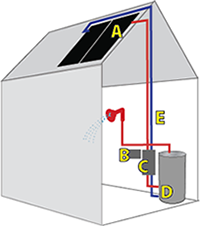What are Solar Thermal Systems
(Solar Hot Water)Solar thermal is the collection, storage, and use of heat from sunshine. It is one of the most efficient means of using solar energy. Think about how hot your car gets when you park it in the sun – with a solar hot water (thermal) system, you capture this energy and make it work for you.
There is a huge amount of energy in solar radiation, and the sunshine on one square foot in one year is equal to the energy in 2.5 gallons of oil. Two or three collectors can easily supply all the hot water for an average family on sunny days. Even on cloudy winter days, collectors can make a substantial contribution and cut utility bills.
Kansas ranks high in its potential for Solar Energy.

Compared to the rest of the world areas in Kansas have as much solar radiation as areas in South America and Africa.

A wide range of solar hot water (thermal) technologies exist.
Solar hot water (thermal) energy systems capture the heat of the sun and use it to heat water. A properly installed system works year-round even when it’s cloudy.
Basic solar hot water systems for residential and commercial applications work very well to supply daily hot water needs. Space heating systems can be sized for any application including residential homes and commercial businesses. Pool heating collectors will offset traditional demands and lengthen the swimming season. Parabolic trough systems can be used for high temperature applications to supply space heating/cooling or high temperature industrial process heat. Industrial parabolic trough sized systems can even be set to drive steam turbines and generate electricity. There are two types of solar hot water systems that work in a freezing climate: Drainback and Pressurized Glycol Systems.
Drainback Systems
Drainback systems are the least expensive and most simple freeze protected systems. They use water for the solar fluid and basic plumbing methods for installation. They have been used for over 100 years.

How Drainback Systems Work:
Drainback systems are effective and reliable. The water drains back into a reservoir when the sun isn’t providing enough energy to heat water in the collector. When the temperature reaches a set point in the collector the pump turns on and circulates the water through the panel. When the temperature meets the specified temperature the pump turns off and the fluid drains down into the reservoir. In this manner the heat transfer fluid is never exposed to cold temperatures and never freezes.
Pressurized Glycol Systems
In some cases a drainback system will not work because the fluid will not drain completely when the pump is off. In that case, a pressurized glycol system is used.

How Pressurized Glycol Systems Work:
A) The sun heats a non-toxic, freeze-proof solar fluid in the solar collectors on the roof.
B) The controller detects that the collector fluid is hotter than the water in the hot water tank.
C) Solar fluid is pumped from the collector to the hot water tank.
D) The solar fluid flows through a pipe coiling inside the hot water tank, and heats the water in the tank. The hot water is available for use in the house.
E) The solar fluid is pumped back up to the collector, where it is once again heated by the sun.
Pool Heating
Pool Heating systems are relatively inexpensive and can add two or three months onto your swimming season in cooler climates.

How Pool Heating Systems Work:
A) Using the existing pool pump, pool water is directed through a series of valves to the solar collectors.
B) Pool water enters the solar collectors at the bottom and rises to the top through the individual tubes of the collector.
C) As the water rises through the collector it is heated by the sun’s radiant energy.
D) The swimming pool water is then returned to your pool to repeat the cycle until your pool is warm.
Parabolic Trough Systems
For larger commercial or industrial applications, these systems can use the sun to supply high temperature process heat, air conditioning, and even electricity generation.

How Parabolic Trough Systems Work:
A) The sun’s rays reflect off the parabolic trough which concentrates the sun’s energy onto a centrally located receiver tube.
B) Heat transfer fluid traveling inside the receiver tube absorbs the concentrated solar energy.
C) The heat transfer fluid temperature increases to 500°F it as passes through a series of collectors called a row. The energy from a number of rows are converted to useful High Temperature Heat.
D) High Temperature Heat becomes the fuel to power different applications in utility and industrial sectors including power generation, solar thermal air conditioning or process heat.
Am I a candidate for a Solar Thermal System?
In our region, natural gas is fairly inexpensive. So, it may be best to continue to heat your hot water with natural gas. However, if you are heating a pool with electricity, for example, solar thermal may help reduce your energy costs. Good Energy Solutions can help you determine if your home or business is a good candidate for a Solar Thermal System. Contact us to inspect your property for proper sun exposure; and advise you on whether or not a solar thermal system is right for you or your business.



